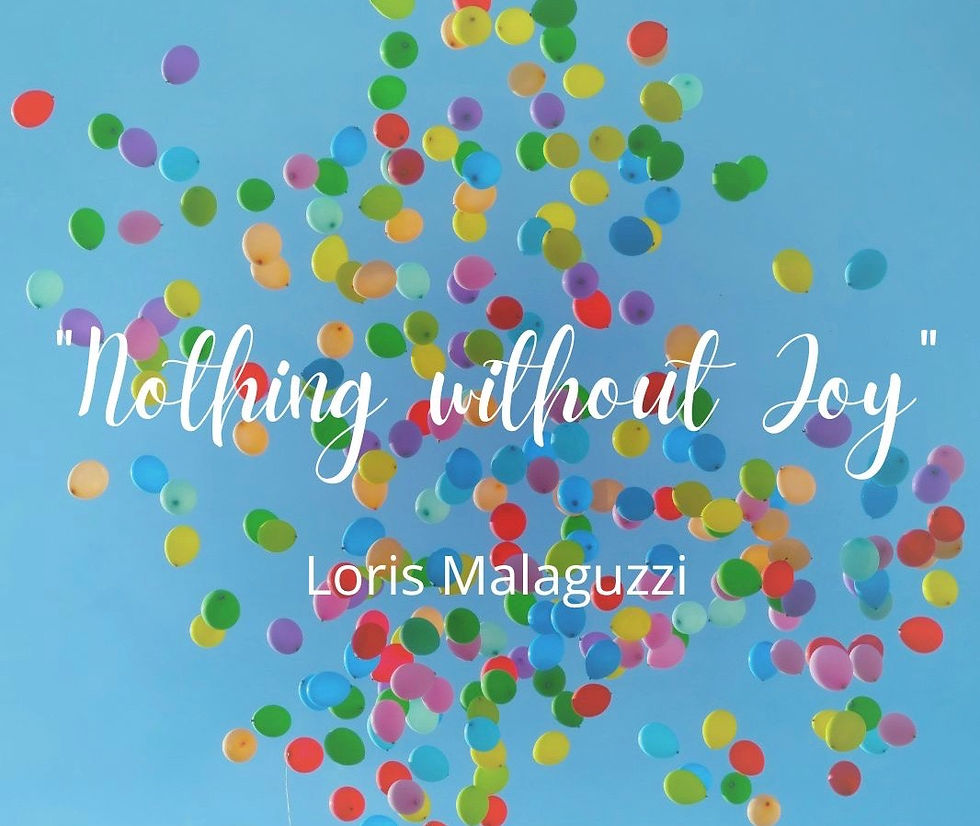What Five Adjectives Best Describe Young Children?
- marywbell53
- Jul 5, 2022
- 4 min read
Updated: Jul 5, 2022
“Your image of the child is where teaching begins.”
Loris Malaguzzi

When I begin consulting in a new context, I often ask teachers to write five adjectives they believe best describe young children.
Then, I collect their lists and write the words on a white board, noting if a word is used more than once. This simple exercise highlights similarities and differences in their perspectives, and becomes the starting point for meaningful discussions about their image of children and their approach to teaching.
During the past three decades, the strong image of the child embraced by the educators of Reggio Emilia - “capable, competent, and filled with potential” – “citizens with rights” – “producers of culture” - has become part of my educator DNA. It guides my way of thinking about and being with children and is a reference point for my decision-making.
But, until now, I had never done what I have asked of other teachers – describe young children using five adjectives.
It was extremely difficult; not because I struggled to think of words, but because I could only choose five. Each list I created omitted an essential quality. So…I broke my own “rules” and chose six:
Capable – Curious – Creative – Connected – Present - Wise
Capable, curious, and creative are simple adjectives, but their implications for teaching and learning are complex.
Children are capable and competent and deserve to be treated with respect. Respect does not mean letting children be in charge. It means not doing for them what they can do for themselves. It means speaking with them in a way that is not demeaning. It means genuinely seeing them, hearing them, and valuing their ideas and questions rather than dismissing them as “cute”.

Children are intensely curious, unless they are taught not to be.
Nurturing their curiosity challenges me to provide opportunities for exploration, ask open-ended questions, allow them to test their theories (even when I know they might fail), and trust them to follow their own interests rather than requiring them to follow mine.

Children are innately creative.
They don't just think outside the box - they don't know that there is a box!
Children deserve the time, space, materials, and encouragement to express their ideas and imaginings through all of the Hundred Languages that Malaguzzi described so eloquently.
Connected, present, and wise - these are more ambiguous descriptors, but they speak to the essence of children’s being.
Human beings need connection with one another and the world around us. It is how we survive when we are young, and how we live emotionally healthy lives as adults.

It is the desire for friendship that prompts a child to share a toy or follow the lead of another child during play. It is children’s connection with nature that inspires them to watch with awe as a centipede crawls on their hand.
It is the trust children have in those who care for them that makes adults’ words and actions so powerful – and a teacher’s role both a great privilege and a great responsibility.
While adults use meditation and other strategies to help them be in the moment; children are naturally present. They live in the moment and are fully focused on whatever they are doing or feeling. And, once they have completed an experience, expressed an emotion, or processed a challenging situation to their satisfaction, they let it go and move on - something adults struggle to do.
I try not to disrupt children's focused presence with my questions or suggestions. It is an art to know when to speak, and when to observe, listen, and learn – an art one never fully masters.

Children are wise. They do not have adults’ repertoire of factual knowledge; but their insights shine a light on beauty we are too busy to see, questions that are too complex to answer, and problems that seem too difficult to solve.
During a conversation she shared in a TEDx Talk, Alise Shafer Ivy asked a group of children why several people can hear the same words, but only one gets an idea from them. A child replied: “You closed your brain, so it didn’t fit. It bounced off.”
We adults too often close our brains to new ideas; while children’s brains
- and hearts - are always open.
The image of the child is relevant to more than teaching.
It is where relationships, not just teaching, begin. Parents, grandparents, aunts and uncles, nannies, pediatricians, neighbors – all adults who have a connection with children - hold an image of the child that, whether consciously or not, informs the way they think about and interact with them.
Politicians and leaders of government agencies also have an image of the child, and it influences the laws and polices that impact every aspect of children’s lives. Nelson Mandela called this influence “society’s soul”, but it might also be called “society’s image of the child”:
"There can be no keener revelation of a society's soul
than the way it treats its children."
Nelson Mandela
What could happen if we each asked a group of teachers, or parents, or politicians, or a random group of adults to write and discuss their five adjectives?
What insights could we gain? What actions and changes could we consider?
What are your five adjectives?
Take some time… Think about it… it’s important.
Please share your thoughts in the comments.



Comments